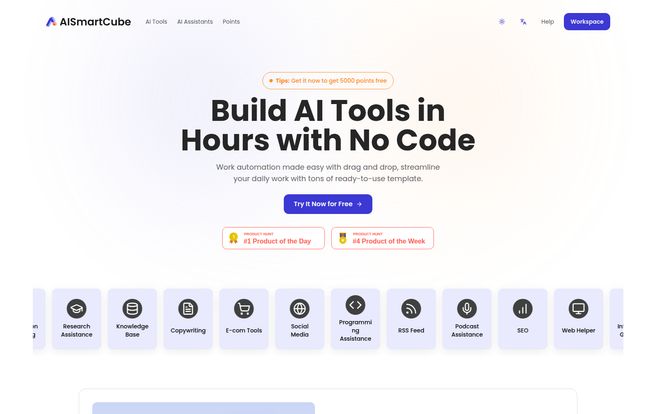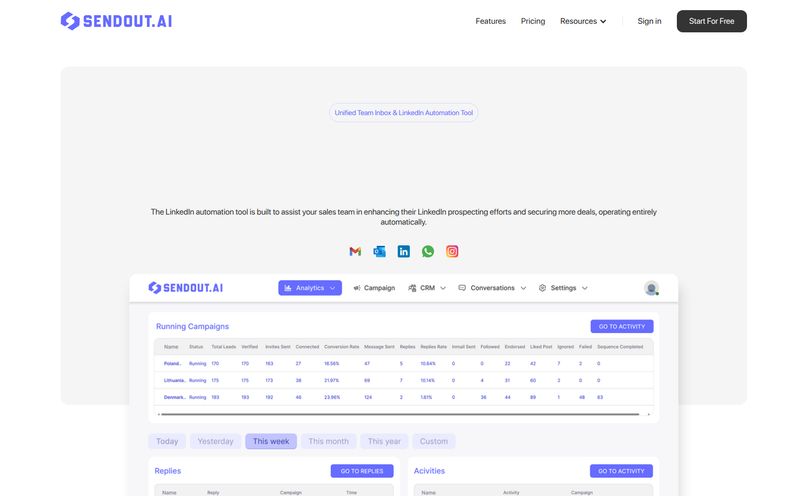The AI space is getting… crowded. Every single day, there's a new AI writer, a new image generator, a new 'revolutionary' tool that promises to handle all your marketing for the price of a coffee. I’ve seen hundreds of them. As someone who lives and breathes SEO and traffic generation, most of them feel like slightly different flavors of the same vanilla ice cream.
But every now and then, something different catches my eye. Not just another tool, but a toolbox. That's the vibe I got when I first stumbled upon AISmartCube. It's not trying to be your one-size-fits-all AI solution. Instead, it’s handing you the blueprints and a box of high-tech LEGOs to build the exact solution you actually need. And you can do it without writing a single line of code. Color me intrigued.
So What Is AISmartCube, Really?
Forget thinking of this as another ChatGPT wrapper. AISmartCube is a low-code platform. That's a fancy way of saying it’s designed for smart people (like you!) who aren't necessarily developers. It gives you a visual, drag-and-drop interface to stitch together powerful AI models (like the brains from OpenAI, Claude, and Gemini), plugins, and your own data to create custom AI applications and assistants.
Think about it. Instead of forcing a generic AI writer to understand your brand's quirky tone of voice, you can build an assistant that’s been trained on your specific style guide from day one. It's like the difference between buying a suit off the rack and getting one tailored. Both will cover you, but only one feels just right.
My First Impressions and The Features That Matter
When you land on their page, you see the usual promises: “boost productivity,” “streamline workflows.” But it's the how that's interesting here. The platform has even been recognized on Product Hunt, which in our world, is a pretty decent signal that they're doing something right.

Visit AISmartCube
The Drag-and-Drop Magic
The core of the experience is the builder. You literally drag components onto a canvas and connect them. “When a user types this, send it to the Claude AI model, then take the output and run it through a data scraper, then format the result.” It’s a visual representation of a workflow. It takes a minute to get your head around, but once it clicks, you start seeing possibilities everywhere. I’ve spent years trying to duct-tape tools together with Zapier, and this feels like the next evolution of that idea, but specifically for AI tasks.
Your Personal AI Army: Assistants and Tools
This isn't just about one-off tasks. The goal here is to build persistent “AI Assistants” or “AI Employees.” Imagine a dedicated AI for your SEO team that can analyze SERPs on command. Or a social media assistant that you can just tell, “Draft me three tweets about our new blog post in a witty tone,” and it knows exactly what to do because you built its brain. They offer a bunch of official templates to get you started, which is a smart move. It lowers the initial learning curve, you can just copy a template for a 'Social Media Assistant' and start tweaking it to your needs.
The Shared Brain: Knowledge Bases
This, for me, is the absolute killer feature. You can create your own Knowledge Bases. This is where you upload your company’s internal documents, your best-performing articles, your product specs, your customer support chat logs... whatever. The AI tools you build can then reference this private knowledge. This is how you get an AI that truly understands your business. It's not just using public internet data; it’s using your data. This is what separates a generic bot from a genuinely helpful digital team member. It's a massive step up from endlessly copy-pasting context into a prompt window.
Who Is This Platform Actually For?
Look, if you’re a hard-core Python developer who loves building things from scratch, this might feel a bit like having training wheels. But you're probably not the target audience.
In my opinion, AISmartCube is perfect for:
- Marketing Agencies: Imagine building a custom-branded tool for each client. One for blog ideation, one for ad copy, one for reporting summaries. It’s a huge value-add.
- Solopreneurs and Creators: You're the CEO, CMO, and janitor. Automating repetitive tasks with a custom-built assistant could literally save you hours every day.
- SEO Professionals: The potential to build small, nimble tools for keyword clustering, internal linking suggestions, or SERP analysis without waiting for a developer is huge. HUGE.
- Small Business Owners: Create an internal help-desk bot trained on your company policies or a first-line customer service assistant that can handle 80% of queries.
Basically, if you’ve ever said, “I wish an AI could just do X, Y, and Z for me,” and you're tired of waiting for someone else to build it, this is for you.
Let’s Talk Money: The AISmartCube Pricing Model
Okay, pricing. This is where it gets a little different. AISmartCube doesn't use a typical monthly subscription model. Instead, it operates on a credit system they call 'Points.' You buy a pack of points, and every action you perform—like calling an AI model or running a workflow—consumes a certain number of them.
Based on their site, the pricing looks something like this:
| Points | Price |
|---|---|
| 10,000 | $9.90 |
| 50,000 | $19.90 |
| 200,000 | $29.90 |
I have mixed feelings about this. On one hand, pay-as-you-go is fantastic for people with inconsistent usage. You're not paying a high monthly fee for a tool you only touch a few times. On the other hand, it can be hard to predict costs, and there's always that little bit of anxiety about 'running out of credits' in the middle of a big project. It's a double-edged sword, but I appreciate the flexibility it offers.
The Good, The Bad, and The AI
No tool is perfect. After playing around with it, here’s my honest breakdown.
What I Love About It
The accessibility is just fantastic. The idea of building your own AI tools has always felt like a far-off dream for non-coders, and AISmartCube makes it a tangible reality. The access to multiple top-tier models (ChatGPT, Claude, Gemini) is a major plus—you’re not locked into one AI's 'personality' or limitations. And as I mentioned, the shared knowledge base feature is, in my professional opinion, a complete game-changer for creating truly customized AI experiences.
Where It Could Improve
Let's be real. While it's 'low-code', it's not 'no-thought'. You still need to think logically about how to structure your workflows. There's a learning curve. Also, you are dependent on their credit system. If you plan on heavy, enterprise-level usage, the costs could rack up, and you need to monitor that. Finally, you're always going to be limited by the building blocks the platform provides. For 95% of use cases, it's more than enough. But for that last 5% of hyper-specific, complex applications, a full-code solution will always offer more granular control.
Final Thoughts: Is AISmartCube Worth the Hype?
So, what’s the final verdict? I'm genuinely excited about platforms like this. AISmartCube represents a shift from just using AI to creating with AI. It democratizes AI development in a way that feels practical and powerful.
Is it going to replace your entire tech stack overnight? Probably not. But could it become the central hub where you build the missing pieces of your workflow puzzle? Absolutely. For marketers, creators and small business owners who want to get their hands dirty and build bespoke AI solutions without a single line of code, I think AISmartCube is more than worth a look. It might just be the most powerful toolbox you add to your arsenal all year.
Frequently Asked Questions
- Do I need to know how to code to use AISmartCube?
- Nope! That's the whole point. It's a low-code platform built around a visual drag-and-drop interface. If you can map out a flowchart, you can build a tool in AISmartCube.
- What AI models can I use with AISmartCube?
- It integrates with several of the big players, including models from OpenAI (like ChatGPT), Anthropic (Claude), and Google (Gemini). This gives you great flexibility to choose the best model for a specific task.
- How does the 'Points' pricing system work?
- It's a pay-as-you-go system. You buy a bundle of points, and different actions within the platform, like running a complex workflow or making a call to a powerful AI model, consume a certain number of points. It's great for controlling costs if your usage varies.
- Can I share the tools I build with my team?
- Yes, you can create and deploy applications and assistants that can be used by others in your organization, making it a great solution for team-based workflow automation.
- Is AISmartCube better than just using ChatGPT directly?
- It's different. Using ChatGPT is like having a conversation. Using AISmartCube is like building a specialized machine that has that conversation for you, repeatedly and consistently, with added powers like accessing custom data and connecting to other services.
- What are the shared knowledge bases for?
- This feature allows you to upload your own private documents and data. Your AI tools can then use this information to provide answers and perform tasks that are highly specific to your business, brand, or project. It's a way to give your AI a custom brain.



